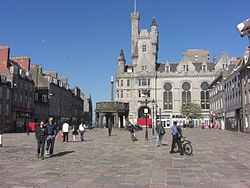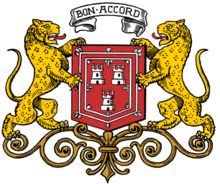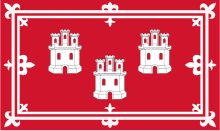Aberdeen Castle
Aberdeen Castle was a late Middle Ages fortification,[1] in Aberdeen, Scotland.[2] It was situated on Castle Hill, a site today known as the Castlegate, and the location of the castle is now occupied by blocks of flats.[3]
| Aberdeen Castle (destroyed c.1308) | |
|---|---|
| Aberdeen, Scotland | |
 Castlegate, Aberdeen | |
| Coordinates | 57°08′57″N 02°05′25″W |
| Site information | |
| Condition | Destroyed, no remains. |
| Site history | |
| In use | until c.1308 |
| Demolished | c.1308 |
| Garrison information | |
| Garrison | Variously between Scottish and English troops. |
Burned and demolished
It is thought the castle and fortifications were slighted[4] by King Robert the Bruce as was his policy on re-captured castles in June 1308, during the Wars of Scottish Independence immediately following the Harrying of Buchan. Bruce and his men laid siege to the castle before massacring the English Garrison to prevent its use by the English troops of Edward II. It is said the Scots showed no mercy but "slew every man who fell into their hands. Edward I, indeed, had already set the example of executing his prisoners, and it was not to be expected that the other side would fail to follow the same course"[5] However, as in August 1308, Gilbert Pecche and the last troops were allowed to leave Aberdeen, this obviously cannot be accurate.[1] On 10 July 1308, English ships left Hartlepool to help the English garrison.[6]
Legend tells that the city's motto, Bon Accord, came from the password used to initiate Bruce's final push and destruction of the castle.[7][8]
Surrendered to English
The castle was surrendered to the English in 1295 and on 14 April 1296, the English King, Edward I arrived in Aberdeen and stayed in the castle as part of his suppression of the east coast of Scotland having defeated the Scots.[9]
Wallace
However the next year, after defeating the English at Dunnottar Castle in 1297, William Wallace marched his men to Aberdeen during their campaign to retake the east-coast for the Scots.
They found the English hastily preparing to leave in an armada of one hundred ships. The speed of Wallace's arrival from Dunottar caught the English unawares and at low tide the stranded ships were attacked in the harbour, the crew and soldiers slaughtered, the cargo taken and the ships burnt.
John Balliol
The English Sheriff of Aberdeen, Sir Henry de Lazom had been left in charge of the Castle, but during the chaos of the attack he defected, declaring it in the name of the Scottish King, John Balliol.[10][11]
References
- "New Tolbooth exhibition puts unique spotlight on Aberdeen's castle". Aberdeen City Council. Archived from the original on 29 January 2007. Retrieved 3 May 2007.
- "Aberdeen Castle". CANMORE. Royal Commission on the Ancient and Historical Monuments of Scotland.
- "The Castlegate- Aberdeen". Aberdeen Today. Archived from the original on 23 January 2007. Retrieved 3 May 2007.
- "Welcome to Aberdeen". Destinations in Scotland. Archived from the original on 4 May 2007. Retrieved 3 May 2007.
- George Lillie Craik and Charles MacFarlane (1841). The Pictorial History of England: Being a History of the People, as Well as a History of the Kingdom. C. Knight & Co. p. 709.
Castle of Aberdeen.
- "Notable Dates in history". Archived from the original on 11 February 2007. Retrieved 3 May 2007.
- Keith, Alexander (1987). A Thousand Years of Aberdeen. Aberdeen: Aberdeen University Press.
- "Aberdeen Official Guide – Coat of Arms and Motto". British Publishing. Archived from the original on 14 November 2006. Retrieved 3 May 2007.
- "Journal of the Movements of King Edward I in Scotland, 1296". Archived from the original on 29 September 2007. Retrieved 3 May 2007.
- "Andrew de Moray Unsung Hero of Scotland's Wars of Independence". Retrieved 3 May 2007.
- "Rebel Commander". Archived from the original on 16 May 2007. Retrieved 3 May 2007.

